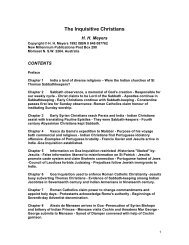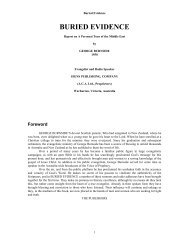Battle of the Bibles - Present Truth
Battle of the Bibles - Present Truth
Battle of the Bibles - Present Truth
Create successful ePaper yourself
Turn your PDF publications into a flip-book with our unique Google optimized e-Paper software.
handed to <strong>the</strong> revisers stipulated that changes were to be limited to "plain and clear"<br />
errors, <strong>the</strong> finished revision brought forth a staggering 36,000 changes in <strong>the</strong> English <strong>of</strong><br />
<strong>the</strong> KJV and close to 6,000 in <strong>the</strong> Greek Text.<br />
Canon Cook had no doubts as to <strong>the</strong> origin <strong>of</strong> those changes:<br />
"By far <strong>the</strong> greatest number <strong>of</strong> innovations, including those which give <strong>the</strong><br />
severest shocks to our minds, are adopted on <strong>the</strong> authority <strong>of</strong> two manuscripts, or even<br />
one manuscript, against <strong>the</strong> distinct testimony <strong>of</strong> all o<strong>the</strong>r manuscripts, uncial and<br />
cursive .... The Vatican Codex, ... sometimes alone, generally in accord with <strong>the</strong> Sinaitic,<br />
is responsible for nine-tenths <strong>of</strong> <strong>the</strong> most striking innovations in <strong>the</strong> Revised Versions"<br />
(Cook, "Revised Version", pp 227, 231; cited in "Our Authorised Bible Vindicated", pp<br />
175, 176).<br />
It should be a matter <strong>of</strong> great concern for all honest Christians that <strong>the</strong> vast<br />
majority <strong>of</strong> succeeding revisers have enthusiastically followed <strong>the</strong> fraudulent example <strong>of</strong><br />
Westcott and Hort.<br />
A quick glance over <strong>the</strong> foregoing analysis shows a decided trend on <strong>the</strong> part <strong>of</strong><br />
modern versions to emulate and build upon <strong>the</strong> doubt fostering suggestions and<br />
depravations <strong>of</strong> <strong>the</strong> Revised Version.<br />
Yet, ano<strong>the</strong>r very significant observation is pertinent. Glancing back over <strong>the</strong><br />
foregoing comparison <strong>of</strong> Scripture, one is struck by <strong>the</strong> frequent absence <strong>of</strong> conflict<br />
between <strong>the</strong> Douay and <strong>the</strong> King James Version, especially in those texts which deal<br />
with <strong>the</strong> divinity <strong>of</strong> Christ and His incarnation. Why is it that <strong>the</strong> Douay stays closer to <strong>the</strong><br />
KJV than most later versions? Is it, as claimed by <strong>the</strong> Roman Church, because <strong>the</strong><br />
translators <strong>of</strong> <strong>the</strong> KJV relied heavily on <strong>the</strong> Catholic Vulgate? The short answer is no!<br />
And, here are two reasons. First, let us hark back to <strong>the</strong> times <strong>of</strong> Constantine, Eusebius<br />
and Jerome, that have been discussed in Section two, Chapter fourteen.<br />
Both <strong>the</strong> Sinaiticus and <strong>the</strong> Vaticanus manuscripts are thought to be surviving<br />
copies <strong>of</strong> <strong>the</strong> fifty <strong>Bibles</strong>, which Constantine commissioned Eusebius to produce. Being<br />
written on vellum (animal skins), and later being made redundant with <strong>the</strong> <strong>of</strong>ficial<br />
adoption by Rome <strong>of</strong> Jerome's Latin Bible, it is not surprising that <strong>the</strong>y have survived in<br />
isolation.<br />
We have noted how Jerome was sensitive to <strong>the</strong> criticism <strong>of</strong> <strong>the</strong> Milan<br />
(Waldensian) scholars who used <strong>the</strong> Itala type Bible (later branded by Rome as <strong>the</strong><br />
Waldensian Bible). This early Bible was known as <strong>the</strong> Latin Vulgate or popular Bible. As<br />
a measure <strong>of</strong> <strong>the</strong> esteem in which <strong>the</strong> Itala (Vulgate) was held, even by <strong>the</strong> Roman<br />
clergy, let us be reminded <strong>of</strong> what <strong>the</strong> celebrated Augustine (354-430 AD) had to say:<br />
"Now among translations <strong>the</strong>mselves, <strong>the</strong> Italian (Itala) is to be preferred to <strong>the</strong><br />
o<strong>the</strong>rs, for it keeps closer to <strong>the</strong> words without prejudice to clearness <strong>of</strong> expression "<br />
("Nicene and Post Nicene Fa<strong>the</strong>rs", [Christian Lit Ed] Vol. II p 542).<br />
As noted in chapter fourteen, in <strong>the</strong> interests <strong>of</strong> pr<strong>of</strong>essional credibility Jerome<br />
also consulted early Greek manuscripts (such as would have been available to Lucian),<br />
and so ended up with a Bible that was closer to <strong>the</strong> Itala than Constantine's Bible<br />
produced by Eusebius. This is not to say that Jerome's Bible did not contain error. It did,<br />
for it was a compromise! Today, his Bible could be described as an ecumenical version<br />
in <strong>the</strong> language <strong>of</strong> <strong>the</strong> common people.<br />
However, it took centuries for Jerome's Bible to gain popularity and eventually it<br />
assumed <strong>the</strong> name first given to <strong>the</strong> Itala, "<strong>the</strong> Vulgate". Even so, a full millennium later,<br />
at a time when <strong>the</strong> return <strong>of</strong> Greek literature and learning were dispelling <strong>the</strong> gloom <strong>of</strong><br />
<strong>the</strong> Dark Ages, notable Catholic scholars were still denigrating Jerome's Catholic<br />
Vulgate.<br />
15





